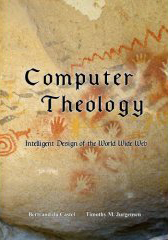PRESS
COMPUTER THEOLOGY |
||||
|
competitive
position, and therefore their interests will be in having as level as possible
a field of competition, less they can tilt it in their favor. That’s exactly
what happened with personal computers, where several PC companies ended up in
strong positions. However, they didn’t manage to avoid the first rule
altogether as the standards they relied on took the names of Intel and
Microsoft, now dominating as much as their predecessors, but in a new field. This allows one
to recognize the second evolutionary trait as the emergence of standards.
Standards are agreements across some domain that levels the competitive field.
In essence, companies agree to sacrifice some of their margin of maneuver so
that the entire market progresses in a way beneficial to them individually.
They either do this of their own volition, to avoid having one of them
eliminate the others, or they do it under pressure from their customers, who
want to avoid depending on a single source. In any case, they give up on the
capability to accumulate superior profits that only a dominant position can
provide in the long term. Standards can be
de facto (emerging), or de jure (the result of committee work).
In the case of personal computers, the microprocessors and software standards
ended up being set by two companies. The computer manufacturers had
successfully avoided a dominating computer manufacturer. However, they had
created Intel and Microsoft in the process. These companies became dominant in
their own areas and took with them most of the profit of that industry. This
lesson would not be lost on personal electronic devices manufacturers, who
would carry computer history to multi-level selection. Epochs of Computer Evolution
Over the last
century, the evolution of computer technology can be assessed through four
epochs following a prologue period in which the computer species actually emerged
in a recognizable lineage. This prologue period is concerned with the
development of the basic technologies of electronic components, circuits and
memory systems that allowed the realization of stored-program computing
systems. We suggest that this progression is best presented as a series of
mutation events relative to the mechanical computing devices that had gone
before. The first real
epoch of computers is the mainframe era. This involved the construction of
large machines with large price tags. Moreover, the mainframe era entailed the
first division of labor between the hardware that comprises the anatomical entities
that are computers and the software that actually effects their physiological
manifestations. Interestingly enough, during the mainframe era the development
of software outpaced the development of hardware such that the general
cognitive abilities of large mainframes was extremely advanced, even by current
standards that are well along the computers’ evolutionary ascent. The software capabilities
of early mainframes, if mapped into current hardware architectures, make one
consider what the evolutionary outcome might have been if dinosaurs, in
addition to evolving into extremely large organisms, had similarly developed
enhanced brain sizes as well; perhaps to the relative brain size of humans.
Extremely large, powerful individuals with well developed cognitive abilities;
they might have given Homo sapiens a run for their money. Certainly,
they would have made for truly industrial strength National Football League
franchises. The second epoch is the mini-computer era. This period was induced with the miniaturization of large sections of mainframe computers through the use of integrated circuits. This transition from the mainframe to the mini-computer is viewed as an adaptation transition rather than a true mutational event. With this transition, the mainframe did not lapse into extinction, largely because |
||||
|
||||
© Midori Press, LLC, 2008. All rights reserved for all countries. (Inquiries) The contents of ComputerTheology: Intelligent Design of the World Wide Web are presented for the sole purpose of on-line reading to allow the reader to determine whether to purchase the book. Reproduction and other derivative works are expressly forbidden without the written consent of Midori Press. Legal deposit with the US Library of Congress 1-33735636, 2007.
|
ComputerTheology Intelligent Design of the World Wide Web Bertrand du Castel and Timothy M. Jurgensen Midori Press, Austin Texas 1st Edition 2008 (468 pp) ISBN 0-9801821-1-5 |
Book available at Midori Press (regular) |
